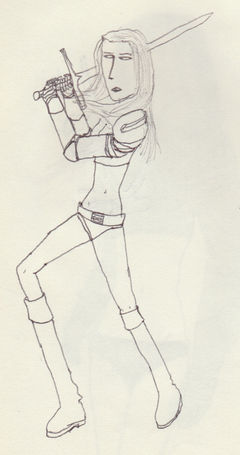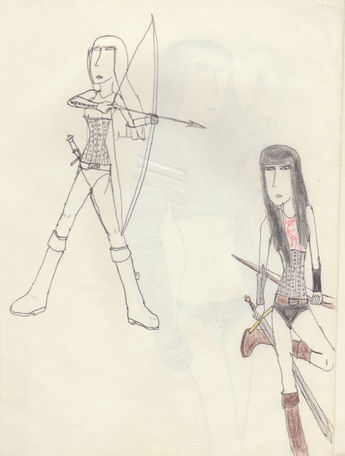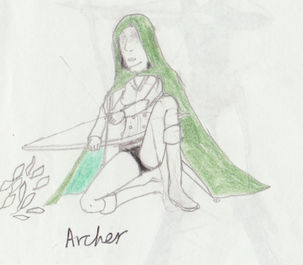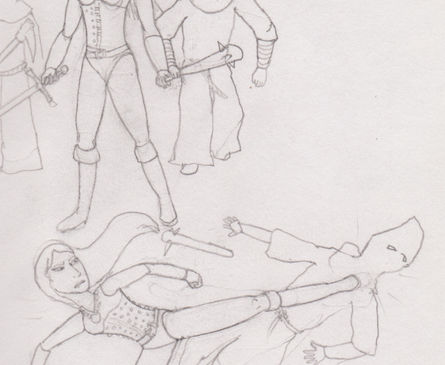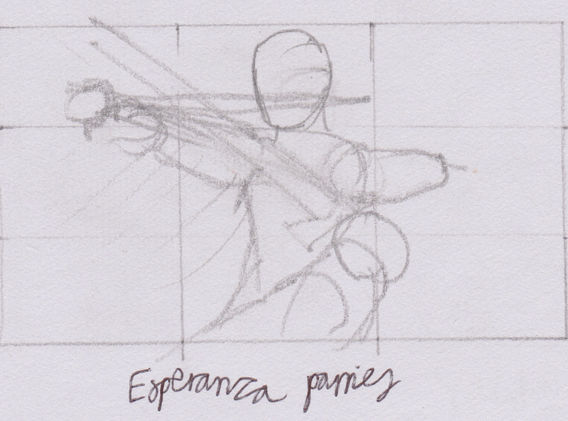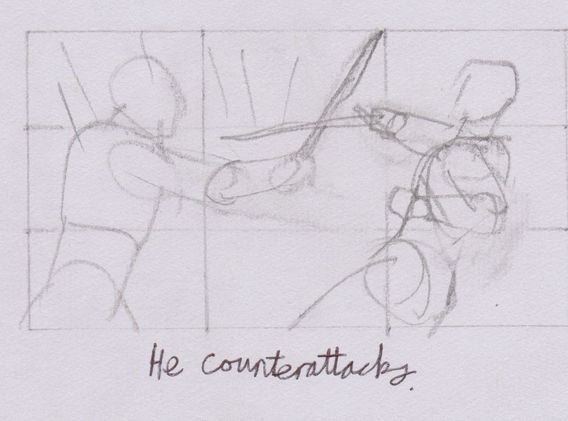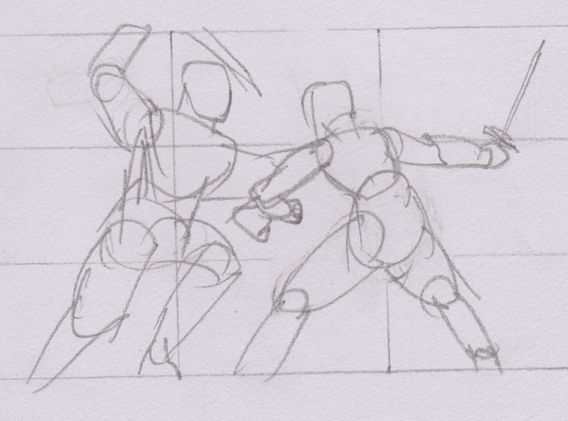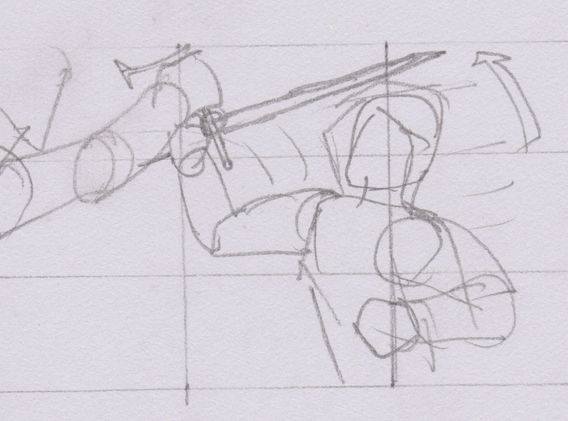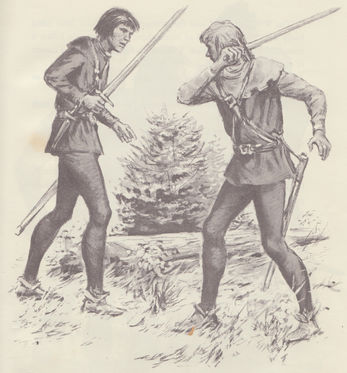top of page

Developing Esperanza Vivar
It had taken some time to decide what aim I was going to pursue when returning for Year 3. Having quite a number of projects to choose from, some of my time was spent sketching and preparing for the start of term. These choices came from a medieval fantasy 'swords and sorcery' world I had developed from when I was a teenager. For a brainchild I have always been fuelling with new ideas, to me there was no better way to release it into public attention than illustration and animation.

Watching 'The Lord of the Rings' trilogy, playing Games Workshop's Warhammer and Dungeons and Dragon's game Baldur's gate were my earliest forays into mythical fantasy. Mythical adventures involving knights, thieves and heroines, coupled with my love of medieval history motivated me to create my own world in the manner of JRR Tolkien who created a war-torn fantasy world in 'Lord of the Rings.'






Scanlon, M. 'Warhammer Monthly - A Gathering of Killers' (2003) Black Library, Games Workshop Ltd. Willow Rd. Nottingham, NG7 2WS, UK
An issue of Warhammer monthly inspired me to depict a strong young woman who goes on an epic quest and fight an evil force. Liliana Falcone, the girl in this comic is an assassin and mercenary who uses acrobatics and swordplay to accomplish her goals.
So depicting the main character as a beautiful but formidable young woman capable of sword-fighting seemed like a surefire way to attract a good audience.
Van Helsing (2004) Stephen Sommers. Universal Studios
Another heroine that inspired me was Anna Valerious from the action-adventure monster movie Van Helsing. Actress Kate Beckinsale dresses in a skin-tight uniform similar to Liliana from the comic with the corset and sword in her belt. Anna does things like somersault, kills vampires and comes from an ancient royal line of warriors committed to killing Count Dracula. Furthermore, some of Universal's monsters, including vampires and werewolves, are the byproducts of medieval superstition, so Van Helsing has elements of an fantasy adventure.


Sithvixen (2007) Femtrooper 5 Available at: https://www.deviantart.com/sithvixen/art/Femtrooper-5-48729925 Accessed 2008
Being so into 'Star Wars,' I was particularly awed by the cosplays by Kristen Caron, or 'Sithvixen.' She projects sexual allure and toughness with her daring stare and her willingness to show off some skin.
I would have drawn these sketches back in 2007 when I was 16. Back then my idea was for my heroine to be an iteration of Queen Guinevere from King Arthur. She shares the bra-shaped armour baring her midriff from Sithvixen's cosplay and Kate Beckinsale's corset from Van Helsing. The possibility of her using a bow and arrow is a tradition of fantasy adventure stories, which might indicate this heroine explores the countryside and forbidden lands to fight all sorts of enemies.
2010 research and sketches - Click on thumbnails to enlarge. Scroll left to view.
Sansweet, S. Vilmur, P. (2007) The Star Wars Vault. 1st. Lucasbooks. becker and mayer, Bellevue, Washington. pp. 33
Grant, J. She-Ra, Princess of Power - Shadow Weaver's Magic Mirror. Ladybird books Ltd, London, UK. pp.18
A couple of years later, I curiously looked at a small ladybird children's book at my old school. This book was based on the 1980s cartoon 'She-Ra princess of Power' and the main heroine wore a leotard exactly like the one my heroine had.
This and watching the series' prologue movie 'The Secret of the Sword' motivated me to revisit my idea of a female warrior, not just by adjusting her colour scheme with green, appropriate for medieval fantasy, but also show that this girl might have lived peacefully at a village before going on adventures. Her dress was inspired by the ones old 'Star Wars' posters depicted Princess Leia wearing. She is shown looking strong and brave while her double slit gown shows off her legs. So my heroine could wear a gown like and go barefoot to highlight her innocent elegance. Showing her in bed and reading books, looking comfortable and relaxed would help bring out another side of her, making her more than just a tough female adventurer. The bow was kept and I christened her Gladia Vailla in an attempt to come up with a flowery fantasy name. Gladius is Latin for sword, and my heroine dresses in leather armour not unlike that of a gladiator.
2013 research and sketches - Click on thumbnails to enlarge. Scroll left to view.
About three years later and following, I went to take drawing and writing sessions at the Folkhouse, an adult centre in Bristol that introduces the creative arts to adults. There I had the chance to expand on Gladia's backstory and exercise in sketching her more. I even sketched her fighting ferociously, as she needed to be a tough young woman. A fellow student at the Folkhouse said she looked like she came out of 'Thundercats,' a 1980s science fiction/fantasy animated series about feline warriors. One of the Thundercats, Cheetara wears a leotard like Princess Adora to bring out her athleticism and beauty.
I did feel undecided on whether to give Gladia's shirt sleeves or show off her arm muscles. If she wore sleeves, she would wear brown leather gloves, but she could have fingerless vambraces (arm protectors) if her arms were bare.
When writing Gladia, I made sure to portrayed her as unsure of her strength before leaving her village to fight. One woman who was also a student said she sounded like a female Superman, so I played on her vulnerability a bit.
Reading a few Wonder Woman comics spurred me on to continue developing my heroine. The following years, her design was carried on through the subsequent drawings, but her backstory needed considerable attention.



After a few trips to Spain, including Toledo, Salamanca and Cordoba, I was instantly enraptured by the history, Moorish and Gothic architecture and mountainous, stark landscape. Medieval Spain was violent, bloody and scary, but the country is also beautiful with its stark rocky landscapes and castles. A new idea was to set my heroine's story in a mystical kingdom inspired by Inquisitorial Medieval Spain. The Spanish Inquisition went after Moorish and Jewish people, making them one of the early examples of religious intolerance and persecution, which could provide good resources for coming up with villains. Things got even better when I was first shown artwork by Fransisco Goya, who viciously satirised Spanish catholicism and superstition through shockingly gothic paintings and etchings. Goya exaggerated sexual lust, belief in demons and lunacy by visually depicting humans morphing monstrously, witches eating children and shockingly violent war scenes. 'Sleep of Reason produces Monsters' shows animals associated with witches, cats, bats and owls swooping nightmarishly around a man asleep on his desk. The message behind this was that to take leave of reason was to give way to insanity, or monsters in Goya's case. He has painted hobgoblins, demons and giants
Eventually my heroine's name went from Gladia to Esperanza Vivar. Esperanza is a name that translates to 'Hope' in Spanish. Vivar comes from the full name of the 11th century Spanish knight El Cid. His name Moorish for 'The Champion,' El Cid was born 'Rodrigo Diaz de Vivar.' He fought fought for and against the moors, as often as he fought for and against the christians. It was decided that Esperanza's father could act as an equivalent of Isperia's El Cid, who fights others out of loyalty but fighting for other cultures it it suits him.
Esperanza's green shirt proved a fortunate accident, because green is the colour of hope, springtime and rebirth. So like Superman who symbolises hope himself, Esperanza could fight an evil cult to inspire persecuted cultures to fight back. These digital illustrations show Esperanza in a Spanish landscape and a cathedral photographed by myself and filtered on Photoshop.

Some time later, the idea dawned on me to give Esperanza a partner to join her on her adventures. First inspiration was 'Baldur's Gate's' sidekick Imoen, a young thief who wears a purple hood and fights with bows and arrows. She helps the main hero/heroine by pickpocketing and stealth. Wilykit from 'Thundercats' has the look and outfit of a pixie, contributing to her catlike character. Stephanie Brown/Spoiler from DC Comics hides her identity with a facemask and hood while she is the most bubbly, optimistic crimefighter out of the Batman family. Sabine Wren from 'Star Wars Rebels' is one of the more colourful, brassy characters of the team, so my sidekick could be a bit of a smart-aleck. Furthermore, actress Kat Dennings plays Darcy Lewis, friend to heroine Jane Foster (Natalie Portman) and comic relief to the film with her bubbly personality and one-liners.
Espana is how Spanish people pronounce the name of their country and it is also called the 'Iberian Peninsula.' To suit its fantastical mystical setting, Esperanza's country was called Isperia, the Peninsula kingdom. It would be full of Gothic architecture, primal wilderness and sorcery because it is a barely tamed country. The idea behind this kingdom is that in a desire to destroy monsters and witchcraft, its people turn to an extremist cult for guidance, thus endangering other ethnicities that co-exist among them. The cult would be named 'The Caprichos' after one of Goya's most famous painting collections.

Esperanza was just part of a larger fantasy world I have been building. Swords and sorcery, as per tradition, has to include dwarves, elves (tall, graceful people, not tiny pixie-like creatures), goblins and ugly warlike beasts like orcs in 'Lord of the Rings.' To explore this, I could have compiled an walk cycle reel of my own different races and characters.
Dwarves were the sort of characters I would have wanted to give a try at animating, because their stature is very distinct from human forms. Being so used to drawing average-sized figures, shorter and stockier anatomy would have presented new challenges for animation. In terms of design, the dwarves would mainly be warriors wearing helmets and armour inspired by medieval men-at-arms (footsoldiers), which would present them as stalwart, hardy warriors. The annotations show what type of tricks I might have tried in animating run cycles.
Interest in exploring other races extended to the beasts, heroes and otherworldly creatures and they might pose and walk. Abraham Vouk was inspired by the 1922 silent horror film 'Nosferatu.' My idea for Vouk was that he used to be an apothecary and alchemist, until his cures reached their limits and he became a vampire out of a desire to transcend human sickness. He would be rail-thin, spidery and hobble eerily. Kraus are vicious, bearded beasts that wage war on kingdoms, so they would lope around in an animalistic manner like Chewbacca from 'Star Wars' or beasts like a Sasquatch. Knights are the more heroic characters, but their heavy armour would make them stomp and stride in an arrogant, austere manner. Dwarves would march proudly and full of bravado. Giants would be especially interesting because they can be as big as mountains, so they would walk on gangly legs as tall as trees and stomp everywhere they stepped. Thieves would walk on tiptoes sneakily while a heroine would stride confidently with her hips swaying alluringly.

Eventually the wish to push Esperanza Vivar into the public's eye started to win out over walk cycles. The question was; in what form would a project surrounding Esperanza's story take?

This poster from Year 2 Illustration encompasses Esperanza's epic adventures in this original fantasy story.
Esperanza Vivar is the centrepiece of the poster, fighting against her own country's repression. She is shown looking contemplative and peaceful, while below she is at the height of her strength, taking on a knight on the side of the Caprichos cult. The cultists are shown marching in procession in front of a cathedral. Sarita stands ready with a quarterstaff while soldiers and knights give chase across the wilderness.

This initial idea was enthusiastically embraced back when it was being storyboarded. One small action scene may have served as a tantalising glimpse into the epic story that Esperanza and Sarita are part of, leaving the audience wanting to know more about what happens next. Before the release of a film, filmmaking companies broadcast small clips online to give the audience a sample and satisfy their anticipation until the final release. This storyboard may have worked as a preview of a full-length adventure film. However, it might confuse whoever watches it, because Esperanza and Sara are not together in the same scene. They might wonder what the relevance is between the two characters, possibly without knowing they are the main duo of the story.

After summing up Esperanza's story in the poster, one idea was to animate a scene from the poster as part of a film, the way clips from an upcoming movie are broadcast as part of anticipation for its release. This scene in particular was the duel between Esperanza and a knight named Hernan Hierro, named after the conquistador, Hernan Cortes with 'hierro' being Spanish for iron. A sword duel would bring out Esperanza's ferocious yet graceful fighting skills and Hernan's ruthlessness. This idea started off as a beatboard, starting with the duellists challenging each other, midway in the duel Hernan cornering Esperanza while taunting her over something like her father, then Esperanza managing to one-up Hernan with a headbutt. This would cover only a sample of one big fight scene, but would last less than a minute.
Drawing these two characters in action presented some interesting outcomes like Esperanza spinning her sword in her hand in preparation to fight and the closeups of the heroine and villain locking swords and staring into each other's eyes. Like the previous idea, it would have also left audiences curious as to how the story they're in unfolds, possibly even whether Esperanza survives the duel or not. But it would have also confused them about the story all the same.
What truly fascinates me about Esperanza is the transition she went from an iteration of Queen Guinevere 10 years ago to a Spanish-inspired swashbuckling heroine. While her costume retains its revealing nature, it is for the best that it covers more than the first version did. In fact, the one-piece has been consistently well-received, even by women. If she had the midriff-baring armour, it would have undoubtedly been controversial in the eyes of female audiences, so the change must have been for the best.
Producing Esperanza Vivar's trailer
The synopsis for this project is a mystical kingdom under threat of domination by an extremist cult about to take control of its culture.
The trailer could possibly show Esperanza's transformation from a fun-loving young woman to a fierce warrior. It could also include some pivotal moments in the story that could get the audience asking. There has to be a certain amount of supporting characters, so Sarita the young bandit should be shown teaming up with Esperanza.
The main plan is to produce a trailer based on this original story. The trailer will cover Esperanza's heroics against the villainous cult to save the people they persecute. Its storyline will echo Robin Hood in that Esperanza and Sarita are outlaws fighting tyrants that have taken power.
The trailer will last a concise amount of seconds covering what the story is about, probably a bit about what happens. It could include some fight scenes and show Esperanza's transformation from a fun-loving young woman to a fierce warrior. There has to be a certain amount of supporting characters, so Sarita the young bandit should be shown teaming up with Esperanza.
From a creator's standpoint, the project should be traditional 2D animation. Hand-drawn animation has simple but bold lining that can afford the freedom of character design and emotions. Furthermore lining can be flexible enough to help choreograph fight scenes like the scenes from DC and Warner Bros Animation's Batman Gotham by Gaslight' and 'The Death of Superman.'
Stop motion would be too static for the action and adventure genre, and seems too quaint to be associated with epic fantasy. 3D animation is quite efficient, but more synonymous with science fiction than fantasy adventure stories.
Sometimes people assume hand-drawn animation to be very basic and flat, and while this can be true, all these cartoons mentioned channel the elegant epic-scale art styles from comic books about superheroes, science fiction and mythical fantasy. Furthermore, the story of Esperanza Vivar is intended to be portrayed in comic book format, and were it to be brought to life in animation, its comic style would have to be preserved to do the story justice.
So 2D animation shall be used in this historically-inspired fantasy-action story.


Hand-drawn animation has connected greatly with epic fantasy. 'Fire and Ice' by Ralph Bakshi is rotoscoped over live actors,
one of which he worked with Frank Frazetta on. Frazetta was one of the most celebrated artists for high fantasy. His epic paintings show muscular warriors like Robert E. Howard's Conan the Barbarian, sensual princesses or femmes fatales and hideous monsters.
Frank Frazetta was a good friend of Bakshi's, who called on him to collaborate in designing and animating a high fantasy movie. Through rotoscoping, Bakshi was able to replicate Frazetta's unbridled action-violence and raw sexual allure.
Filmation's He-Man and She-Ra animated series were played on Saturday mornings in the 1980s, a similar time to Bakshi's fantasy films. They clearly took cues from high fantasy with muscular princes, statuesque warrior women and magical creatures like unicorns, skeletons and spellcasters, except these stories were set in space like 'Star Wars.' While He-Man and She-Ra had the physical power and radiance of fantastical heroes, the syndicated Saturday morning cartoons could not portray violence or death in any visual form. Slapstick was generally accepted, but the heroes and villains never stab or cut off any part of their opponent. In the 1980s, syndicated television animation had yet to depict a sense of conflict and threat effectively, so killing off characters was out of the question. The sense of fantasy adventure should be preserved, but it's not ideal for small children.
Vance, E. G. Barnum, J. H. Adventures (1953) 'Adventures of Robin Hood' Purnell and Sons Ltd, Publicity Products Limited Limited, London. Pp. 1, 2, 19, 27, 29, 33,
Robin Hood, one of the most famous medieval British legends, has the main hero pursuing a charitable cause; stealing from the rich and giving to the poor. Prince John, who taxes the kingdom to poverty, must have been inspired by King John, who absorbed power from his own nobility and was coerced to sign the 'Magna Carta' or Great Charter. Of course the money didn't go to the peasants, but the lords. The fictional Prince John sends the ruthless Sheriff of Nottingham after Robin Hood who is trying to bring the prince to justice for his unfair taxing.
This fully illustrated annual brings the medieval swashbuckler to life with a lavish painterly style and enchanting colour range. The woodland landscape sets the scene in the British countryside where Robin and his merry men live a life of hunting. Similarly Esperanza spends time travelling and battling her way through the wilderness of her country, except Isperia, which will still have forests and some greenery, is inspired by Andalucia therefore it is more mountainous and arid.
Robin Hood is about donating money to the poverty-stricken, which could make the legend an early example of storytelling with a political message. Esperanza's tale is about protecting cultural minorities from prejudiced hate. Robin Hood has passed so far into history that every Tom, Dick and Harry knows how it goes. In this day and age, there is a push for us to identify with different ethnicity, beliefs and sexual orientation. It would do the story a favour it it moved along with the times by having the heroes fighting a higher power for the sake of inclusion and identity. In a way, Esperanza and Sara rob the rich to feed the poor, simply by putting a stop to the persecutions, lynching and mass executions.

Xena Warrior Princess. MCA TV. Universal Television Enterprises (1995-2001)
Xena Warrior Princess, a fantasy television show was picked up very recently and bears a startling resemblance to this story in that the title character is a warrior woman in leather armour, armed with a sword and has raven hair. What's more both heroines have a younger, more energetic girl as their sidekick.
The main differences are Xena uses a chakram, an Indian throwing disc with bladed edges. Xena smiles roguishly, acts pretty tough in the manner of a Byronic hero, fights with acrobatic style and ululates. In fact similarities between her and Esperanza have been cited before.
While it is appreciated that my original heroine reminds people of another who is so well known in popular culture, Esperanza still has to be differentiated so she remains my own. To this end, her Spanish-inspired background should be preserved. Her sword is not a thick Roman-style Gladius like Xena has, but a delicate, ornate rapier with loops above the crossguard. She does few acrobatics as she fights, because she whirls around and balances herself in the manner of a flamenco dancer. Esperanza is less roguish and tough than Xena, so she can be insecure, playful and at other times, have an air of aristocratic authority.
On top of this, Xena is a princess, but more heroines than one can count have been made princesses. A prince or princess is of royal blood, so they have a kingdom over which they have a certain amount of power over. To buck this trend, it had been decided that Esperanza should not be a princess, but a noblewoman. In the Feudal system, the king was at the top with the nobility, the clergy and the knightly orders holding and fighting for his lands, the commoners at the very bottom labouring for their superiors. So Esperanza could be an outlawed noblewoman who has lost her family's land, which adds her bloodline's honour to the already high stakes.
This story will be intended for adults. Although heroines in 1980s animated series for children wore scanty costumes anyway, there is still killing and heavy themes, particularly loss of family and the outright execution of innocent people. The two heroines fight back through violent means, Esperanza killing with a sword and Sarita using her fists. Against such murderous villains, they cannot hold back. This fits in line with the DC Animated movies that have no ties to syndicated TV networking that children's television has. Nevertheless, there is not going to be the gruesomeness of blatantly showing organs, exploding heads or cutting people open. In terms of sexual themes, special care should be taken. The word 'sexy' might be mentioned, but they can certainly be sexually attracted to each other. Esperanza Vivar could attract some attention, welcome or unwelcome. Villains attracted to her might grope her, but could end up getting what they deserved to show how wrong sexual harassment is. Characters in my story might actually have sex. If we get to that stage, touching and nudity will be the most important parts, but full frontal nudity cannot be guaranteed.


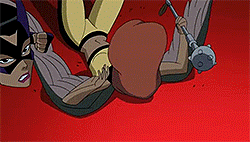
There might be some who question the choice of costume for the story's heroines. Esperanza Vivar was first conceived back in 2010, inspired mainly by Baldur's Gate (Dungeons and Dragons) video games and She-Ra/Princess Adora. It is true that cartoons and comics have depicted female warriors in costumes resembling swimsuits. This can attract its share of objectors. Truthfully DC Comics has courted controversy over this. But if approached tactfully, a heroine's less than conservative costume can actually complement her characteristics, even better, female fans will feel compelled to cosplay as said heroine. Wonder Woman's leotard has become the most iconic superheroine outfit in comics. Though its revealing design has been questioned in terms of appropriateness and practicality, the team behind the Justice League animated series manage to express some self-awareness, while making it clear there is no right and wrong.
By focusing on Wonder Woman's benevolent, if passionate personality, Bruce Timm and Warner Bros have approached the character tactfully, ensuring her costume carries her beauty and confidence, keeping her from being simply eye candy.


Olympic champion Simone Biles has honoured victims of a sex scandal (in which USA Gymnastics team doctor Larry Nissar was alleged) through wearing a teal leotard. In her words, she has reasoned the choice of colour as something "for the survivors." This symbolic act of compassion is shown through confidently wearing an outfit that shows off Simone's physique to the public.
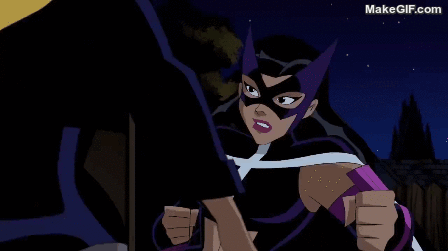
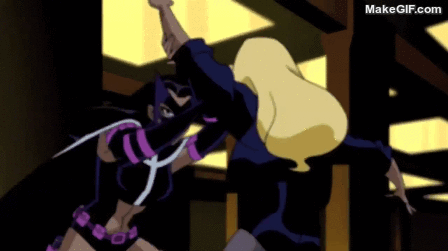


Huntress from 'Justice League Unlimited,' Chel from 'The Road to El Dorado' and Marvel comic's Gwenpool are anarchic antiheroines, which shows in their costume designs. Huntress, like Batman, wears a horned mask and is portrayed as an outcast and maverick. Her leotard exposes her stomach, making her the heroine with the least conservative costume, but she is also the least scrupulous of the Justice League. What helps Huntress's character most is her chemistry with the league's detective, Question. Chel is a citizen of the Aztec civilisation and aids two Spanish conmen in their plan to pass themselves off as gods and steal the city's gold. She robs, seduces, sasses other characters and expresses base sexual tendencies, which earned her a place as an animated crush for several animation enthusiasts. She rouses the two conmen's suspicions by producing their dice she just stole from her loincloth, which warranst their question; "Where was she keeping them?" Gwenpool is a female offshoot of Deadpool, the comedic antihero who kills and wisecracks his way through the action and violence. Bubbly and hip, Gwenpool combines a utilitarian-looking leotard with the sort of shin-pad boots we associate with hockey.
So Huntress, Chel and Gwenpool's scanty costumes underline their less-than heroic traits but their assertive charm allows their sexual appeal to help them shine through.





"If a man is wearing something skimpy, everyone thinks: "Oh, yes!" If a woman does it, they are judged."
Perrie Edwards, Little Mix star
The Spice Girls in the 1990s and Little Mix in the millennial days have been hailed as icons of pop music and female empowerment by their respective audiences. The Spice Girls embodied 'lipstick feminism,' a third-wave idea of feminism that kept its main ideals, but also held on to the raw sexual power. Thus lipstick feminism combined the push for women's rights with the charisma that stems from their feminine charisma.
During the 1997 Brit awards, Geri Halliwell, or Ginger Spice, had the whole audience in her power through wearing platform boots and a Union Jack dress so short it flashed her knickers to the public. She has made it to stardom in pop music through her magnetism as well as her singing.
Little Mix seem to have responded similarly to Wonder Woman about the ways they dress. They have cited the leotard as "comfortable to dance in," particularly as they do about an hour and a half, preferring that to a tracksuit. In fact, they wear just as much as athletes like Jessica Ennis, a role model for British fitness whose gymnastic outfit sometimes looks like a two-piece swimsuit. So if people want to judge Little Mix for wearing leotards to their gigs, they may as well judge Geri Halliwell, Jessica Ennis and superheroines as well.

Virtually there is little problem with how soldiers in high fantasy can look. No requirement for historical accuracy dictates the armour and weapon designs, but they can be played with to evoke the right tone of the story
These costumes, armour and weapons were photographed at Malaga, Andalucia. The musketeer hat and the 16th century armour evoke classic swashbuckling action stories, so early modern period dress will be the core of Isperia as a kingdom.


Bartoszek, J. (2005) Sleep of Reason. [Website] Accessed November 2018. Available at: http://www.hedwigdances.com/repertory-works/sleep-of-reason/
Moore, J. J. (2018) Secret Societies and Creepy Cults. Quarto Publishing Ltd. New Burlington Books, The Old Brewery, 6 Blundell St, London N7 9BH. pp. 183, 188
'The Birth of a Nation,' (1915) [Film, Black and White, Silent] D. W. Griffiths.
Early designs of the Caprichos, like in the comic pages from 2013, took some pretty direct inspiration from the Spanish Inquisition with the bag-like hoods with eyeholes. Fransisco Goya hated the Inquisition for its fanaticism and prejudices, so he sympathetically painted victims standing trial in cone hats and mantles while priests in the Inquisition discuss their punishments.
Most recently, it was decided that to flesh out the Caprichos cult as villains was to look at a group with similar political goals and just as reviled; the Ku Klux Klan.
The Ku Klux Klan serves as a byword for xenophobia and religious fanaticism with their night rides, lynching and flaming cross ceremonies. They were portrayed in a heroic light in the 1915 silent film 'Birth of the Nation' in which Klan members lynch African Americans played in 'blackface' and depicted as sexually assaulting white women. Their red circle centred with the cross made for ample inspiration for the Caprichos' symbol, which was eventually made into a red circle with flames in the centre and a sword in the middle.
People usually picture evil cults as wearing blank pointed hoods with eyeholes. There was a certain amount of deliberation on whether to change this. The pointed hoods with eyeholes, whichever way you try, Spanish Inquisition or Ku Klux Klan, has been done to death. Originally Venetian Carnival masks were considered, because they look glamorous, but also haunting and eerie. Eventually Goya was referenced again, looking at a stage production that realised his art through dance. The masks used in this production are modelled on Goya's grotesque caricatures that embody people at a loss of sanity and giving in to violence. So by wearing these sinister inhuman masks with enlarged noses and eyeholes staring into the soul, the Caprichos cultists are presented as people who have abandoned reason and let themselves become monsters as they try to destroy other cultures.

One character I wanted to include in the trailer in particular was the unscrupulous army sergeant Nemesaro. While Franco de Torqueda, the main villain, is magistrate of the Caprichos cult and Hernan Hierro is a knight who aids them in trying to catch Esperanza (like Prince John and Sheriff of Nottingham in Robin Hood), Nemesaro is a tertiary villain who bosses the other soldiers around. A little twist added to my story is that Nemesaro started off as a town postmaster who tipped off the authorities and the cultists when Esperanza's parents tried to get her and themselves safely out of the kingdom. So he played a part in the loss of Esperanza's family.

McCulley, J. Ushler, J. 'The Monterey Bravo.' (1961) Walt Disney's Zorro. June-Aug. Pp. 3, 4
Jurassic Park (1993) [Film] Steven Spielberg. Universal Studios, USA
As a reward for giving away the Vivars, Nemesaro earned a place in Isperia's army, where he's gone from complaining over neverending mail to bossing around the soldiers at his command. Nemesaro was first based on Corporal Garcia, a lawful-neutral Mexican officer constantly trying to arrest the masked vigilante Zorro under the impression he is a common criminal, not a saviour of the innocent. Garcia is the comic relief of Disney's Zorro tv series, a victim of Zorro's mischief, along with being overweight. He even acts as a villainous equivalent of Sancho Panza, Don Quixote's gullible but good-willed sidekick and 'squire.'
But Nemesaro truly became my own creation when I looked at actor Wayne Knight, who played obese computer nerd Dennis Nedry in 'Jurassic Park' where he is known for the famous Dilophosaurus, or 'Spitter' scene. Aside from trying to play fetch with the Dilophosaur, only for it to splatter him in the face with black venom, Wayne shows his acting prowess when addressing a secret agent as 'Dodgson.' When told not to use his name, Wayne mockingly shouts; 'Dodgson! Dodgson! We've got Dodgson here!" and snorts; "See? Nobody cares." To emphasise his girth, Nedry's table at the restaurant and his workstation are just littered with leftovers of what he has been stuffing his face with.
Seinfeld (1989 - 1998) NBC Season 4 Episode 18 'The Old Man' 1993
Rat Race (2001) [Film] Jerry Zucker. Paramount Pictures, USA
On the sitcom Seinfeld, Wayne played the grumpy mailman Newman who is constantly at odds with Jerry Seinfeld and greets him with a sarcastic "Hello Jerry!" and gets a resentful "Hello, Newman" from Jerry. Even when playing a delivery man in 'Rat Race,' when the bumbling Italian drifter played by Rowan Atkinson loses a donor's heart, Wayne Knight's character is not above trying to use his as a substitute and save his own career. Nemesaro could make an impression to the audience by warranting a grudge between him and Esperanza and Sarita that gets nurtured into a deep-seated rivalry.


'Batman the Animated Series.' (1992 - 1995) [Tv series, Animated] Timm, B. Randomski, E. Fox Kids. Sept 15.
'101 Dalmatians.' (1961) [Film, Animated] Wolfgang Reithermann. Walt Disney Productions. Buena Vista Pictures Distribution.
'Pinnocchio' (1940) [Film, Animated] Ben Sharpsteen. Walt Disney Productions. RKO Radio Pictures.
Animation does have a history with obnoxious fat characters. In 'Batman the Animated Series,' Detective Harvey Bullock hardly gets along with Batman despite the trust between Batman and Commissioner Gordon He scoffs donuts, a common habit associated with the police.
In the Disney animated '101 Dalmatians,' fur-loving Cruella De Ville hires the lean and mean Jasper and his chubby cohort Horace to kidnap a litter of puppies from their loving parents. Horace becomes the butt of the film's jokes, landing face-down into a cake he was going to eat when a cat terrorises him and Jasper, then landing bottom-first into a lit fireplace.
Stromboli from 'Pinocchio' frightened both the main hero and young audiences by switching from "wine-soaked, garlic-breathed Old World Charm" to "chop-you-up-into-firewood" threats as he kidnaps the wooden boy for his travelling puppet show.
For a minor Disney villain, Stromboli made quite an impression with his presence. Animator Vladimir Tytla was praised for providing an "innate sense of force" to this "overweight monster of mercurial moods" and it shows. Stromboli combines bizarre comic relief with sheer intimidation. But as with many of the Disney company's classics, Stromboli has been alleged as an anti-Semitic stereotype with his goat-like beard and love for gold. This is where we should be careful, because Nemesaro is to represent bullying and balance some of the dark themes with his comical villainy.
Having an overweight, obnoxious man as a tertiary antagonist keeps the spirit of the story as a not-overly-serious, fun adventure. This villain can still be nasty, ordering his soldiers about and bullying innocents, but that makes him an acceptable target for Esperanza and Sara to beat him up when he comes after them. But Nemesaro should not be underestimated as a fat, bumbling fool. Get caught by him and he'll make you wish you had killed him when you had the chance.



To keep audiences invested in Esperanza, she needs a wide emotional range. It was important mainly to bring out the happiness and warmth she expresses, but particularly her ferocity and compassion. As a loving character, Esperanza has to feel for others but also show confidence when protecting against evil. What can keep her from being a Xena copy is if she is more emotionally open. Of course Xena has shown amusement and compassion as well, but is not quite as open about it. Esperanza on the other hand may goof around, cry or even express naivete, but should be more elegant and approachable.
Esperanza is presented here as a graceful, battle-ready heroine who places her faith in the sword and her courage. Her leather armour highlights her athletic build and striking beauty. The idea behind Esperanza's role as the protagonist is that she was born to her kingdom's nobility, so she has to have a commanding aura. The sword is ornate to underline Esperanza's aristocratic family ties.

In thinking up Sarita Maza, the idea had surfaced to come up with a foil for Esperanza Vivar. Backstory-wise, Sarita was born Isperian, the kingdom this story is set in, but also Kanaan, this fantasy world's equivalent of Judaism. There is the chance Sarita could be bisexual, which would help push the story to modern conventions and its intentions to fight prejudice. Sarita, or Sara, was a child when learning acrobatics for the circus her family worked for. The cult of the Caprichos lynched Sara's family for their Kanaan blood, which left Sara having to live a life on the road. As a young woman, Sara has become a bandit relentlessly hunted by Isperia's lawkeepers but ever elusive in her criminal career. As a Kanaan, one of the cultures Esperanza is trying to protect, Sara joins her quest despite their outlooks on right and wrong clashing. Their place as outlaws is what brings these two heroines together.
Sarita has a sense of swagger and casual attitude unlike Esperanza's regal bearing. She makes more use of her femininity for deceptive seduction, exploiting the male gender's weaknesses.
Kong Skull Island. 2017 [Film] Jordan Vogt-Roberts. USA. Legendary Pictures, Warner Bros.
Shazam. 2019 [Film] David Sandberg. USA. DC Films, Warner Bros
Music will be an important component of the trailer. In the days of millennial culture, trailers play an integral part in the hype surrounding movies of today. Music tends to boost a trailer's presentation, as shown by these trailers above.
Monster movies abd B-movies were all the rage in the 1950s and 70s, so Creedence Clearwater Revival's 'Bad Moon Rising' evokes the Cold War/Vietnam war period 'Kong' is set in. Following the helicopter montage and 1970s music comes a low, menacing score full of rumbles and tribal drum beats when the monsters attack the human intruders.
'Shazam' presents Billy Batson, a teenager given abilities to transform into a godlike superhero at will, but his boyish energy is retained. At first when Batson is shown being raised in a tough town, an intense but groovy guitar follows his encounter with his foster family and school bullies. When Billy is transformed into Shazam and excitement, gags and chaos ensue, intense orchestral score is combined with a tongue-in-cheek hip-hop track. When Shazam and his schoolmate exchange one-liners, the music pauses. The jokes are delivered in a matter of seconds and timed so that they jump out at the audience to get them laughing.
I contemplated the possibility of using a rock song to complement Esperanza and Sarita in action against the villains. In the early 2000s particularly, rock music tends to be energetic, playful and rebellious. Esperanza and Sarita are outlaws fighting an intolerant establishment, like how Robin Hood steals from Prince John to give to the poor, so rock music might have probably suited the use of violence and the protagonists' anarchic moral alignment.
Play my Game - The Donnas
00:00 / 00:00
'Play my Game' by The Donnas from 2001 sounds like the singer is challenging someone to play a game. Its attitude is quite loud and ballsy. 'Play until we drop' and 'unzip your zipper' sounds a touch suggestive, and Sarita is the cheekier of the protagonists, which may have fit just fine. The roaring guitar would have definitely gone with the furious violence of the action scenes.
That's my Girl - Fifth Harmony
00:00 / 00:00
'That's my Girl' by Fifth Harmony combines daring feminism, sexual allure and raw, heartfelt emotion. Esperanza's backstory does feature family tragedy where the evil cult robbed her of her parents. The chorus of 'That's my Girl' would be where Esperanza and Sarita get into action and the fight scenes erupt. 'That's my Girl' is celebrated as an anthem for female empowerment, which made it quite a contender for the trailer music.
Queen of Swords - Idina Menzel
00:00 / 00:00
Broadway singer Idina Menzel gained prominence for her performance in the musical 'Wicked' and Disney's Frozen, in both of which, she sings 'Defying Gravity' and 'Let it Go,' numbers based on being an outsider and female empowerment. Idina has a powerful presence and her bold, brassy voice commands your attention.
One particular song deemed ideal was 'Queen of Swords,' because Esperanza Vivar fights with a sword, despite being neither a queen or a princess, but a lady/noblewoman/aristocrat. Lyrics like 'I can be like a raging storm' and 'I can be delicate as a flower or a warrior on a throne' would have suited her character well. And the song certainly has the energy and gusto to suit the trailer's action.
One Woman Army - Porcelain Black
00:00 / 00:00
Little Mix's 'Salute' and Porcelain Black's 'One Woman Army' have female empowerment written all over them with their daredevil attitude and fearless feminism. Both of them have rapid beat that could suit the action scenes. Lyrics like 'knocking soldiers down like house of cards' or 'ladies all across the world listen up, we're looking for recruits' give Esperanza and Sarita a powerful presence as they take down the villains.
Nevertheless there were always film soundtracks that could be considered. 'The Mask of Zorro' has always been a favourite of mine and its score sounded Spanish enough to make it the first choice. The late James Horner intensified the music with Mexican woodwind, strumming guitar and clapping castanets. When it wants, 'The Mask of Zorro' soundtrack can be sweeping and majestic or perilous and send you at the edge of your seat.
'The Road to El Dorado' soundtrack by Hans Zimmer and John Powell have a wealth of Spanish guitar and clapping, as well as the sweeping energy of an epic adventure, which would have gone well with the trailer's action scenes. Some of it has Aztec woodwind, which would not fit as well, because this is inspired by a medieval Inquisitorial Spain and has no irrelevance to the Spanish conquest of the Americas.
The field was soon narrowed down to the use of Spanish music that would give this fantasy story a unique flavour among all the medieval Europe tropes people associate with the genre. However it was found out that royalty free music was needed in order to avert copyright issues. Apparently music from over 50 years ago were above royalty laws. Luckily, I had an album of Spanish classical music.
Among the artists who stood out in terms of classical Spanish pieces were Joaquin Rodrigo and Heitor Villa Lobos, both of whom had composed tracks ideal for my trailer back in the 1920s and 1930s.
Choros No1 by Villa Lobos was considered, because of its exotic beauty of its guitar, but the trailer needed efficient pacing, and this track was too slow.
Joaquin Rodrigo's Concierto de Aranjuez comes in two parts. The first phase is lively and spirited. The second, one of the most iconic classical pieces, starts off with mournful flutes and calm guitar strings, then grows in gravitas and wonder.
If these Spanish classical compositions from last century were to be the trailer's music, they would have to fit the mood of everything that happens in the trailer. One part covers the tragedy going on in Esperanza's kingdom which leads to Esperanza becoming a freedom fighter and taking on the villains alongside Sarita.
Trailer Music - Joaquin Rodrigo
00:00 / 00:00

Toon Boom essentials

Deciding it was time I had access to actual animation software, I subscribed and purchased from the Toon Boom website. Last year I had tried to create a Wonder Woman animated trailer on Photoshop through use of the timeline. Trouble was, Photoshop became overloaded with layers, which must have put a strain on the memory. The software was prone to freezing when the play button was pressed to test the footage. What's more Photoshop never shows you the audio pitch of whatever track you put in the timeline. Toon Boom is not only efficient with its animation frames, keeping you from getting lost in the amount of layers, but also shows you how high and low the pitch of the audio is, helping you with the timing.




The drawings were all made with a Monoprice tablet on Toon Boom. The tablet was quite reliable despite drawing into a computer, not on sheets of paper. The pencil strokes on Toon Boom could bend into solid lining, which helped the shapes form strongly.
A few instruction books on how to draw fantasy characters, comics and fight scenes had been instrumental when drawing the figures. The process of starting with shapes then going over those with detailed figures and eventually erasing the shapes have become a tried and true process when illustrating and animating.
There were complications with getting voice dubbing. I had met up with drama student Jemima Osborne in the hopes she had the time. Unfortunately she had deadlines to meet, so voice acting will have to be suspended until Spring term. There might be someone else who could be invited to provide a voice dub.
Fortunately the trailer still has music and I have some stock sound effect tracks converted to MP3 from YouTube videos downloaded from Realplayer and left over from a previous task from Year 2 in Animation. Two girls from last year's drama were kind enough to make feminine grunts and yells as though fighting a battle. Since then the recording has been held on to, particularly in case of an emergency.
I dedicate this animated project to my grandma who shockingly died 4th October, barely a fortnight into my third year at university. When I had the chance, I would walk to visit her at Battenhall road just up Worcester and we would sit and talk over tea. It felt like too much that grandma had to go this soon, but what eased things for us was that she died in her own house at 98 with my dad beside her, not sitting in an old people's home with only other old people and nurses for company. We have celebrated the decades of grandma's company and all the love and care we all shared with her have gone into the story and the making of this animatic. Esperanza Vivar, her friend Sarita and their beloved beasts Elena the horse and Sancho the donkey have many adventures ahead of them and their story shall now be written in honour of my dearly departed grandma, all the kind and sympathetic women I have had the fortune to be my tutors from school through college to University and all the clever young women I have befriended over term time as we have worked our way through higher education. But most importantly, I shall think of all my grandparents, from my mum's side of the family to my dad's as I build this original animated story and several others following.
George Rowland
Presentations
Planning
Essay
bottom of page

